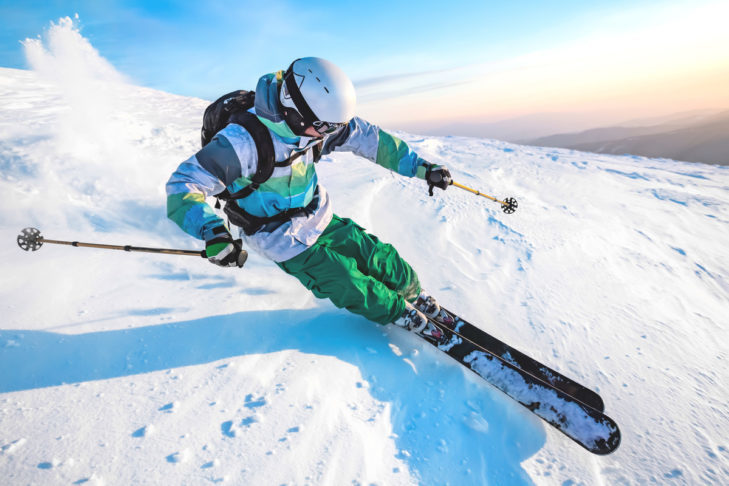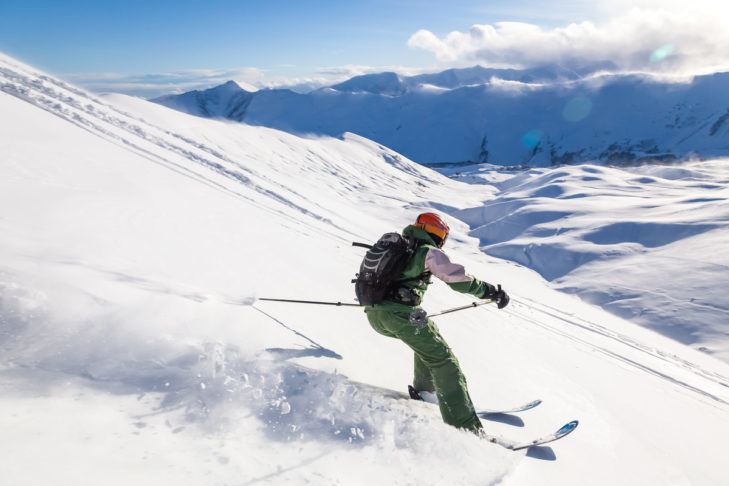Flawless skiing not only has aesthetic reasons. Better skiing also means safer skiing. However, beginners in particular are unaware of a number of mistakes that creep in and become firmly established over the years without correction. We look at the five most common mistakes made by beginners when skiing and explain how to avoid them.
Extreme reserved position
The error
When changing curves, the upper body is moved forward. In order to stand centrally over the ski again after the turn, one compensates this by a slight back swing. But many beginners exaggerate: they perform the backward movement too strongly or too jerkily.
The problem
This puts you in a strong reserved position. The danger is that you may lose control of the skis. This in turn can lead to falls and injuries.
The tip for improvement
Getting into a central position after the forward swing requires some practice and good body feeling. But you can train that: To do this, you stand up straight, close your eyes and bounce back and forth slightly on the sole of your foot. You should consciously concentrate on the difference between a forward movement, a backward movement and a central position. Then you try to transfer this feeling while skiing. You should start at low speeds and then slowly increase your speed. This not only keeps you more stable on your skis, but also saves you strenuous movements and thus preserves your strength.
Wrong distance between skis
The error
It is still difficult for beginners to estimate exactly how far apart the skis have to be. But even experienced skiers have problems with this, especially because modern carvers have changed the skiing style from a narrow distance to a hip-width distance.
The problem
If the skis are too close together, this restricts our freedom of movement enormously. In addition, you can easily lose your balance in an unexpected obstacle. If your legs are too far apart, you can go uncontrolled and risk falling or colliding with other skiers.
The tip for improvement
One possibility is to practice the correct distance when racing down a slightly sloping terrain. It can be helpful to omit the poles first so that you can concentrate on the position of the skis. So the correct distance between the skis is memorized from the beginning and with a bit of practice you will almost automatically keep the correct width. This makes you more controlled and stable at the same time.
Rowing arms
The error
When beginners take on curves, they like to get the necessary momentum out of their arms and turn them strongly during the momentum. Often the hips are also turned.
The problem
If you row hard with your arms, you not only look funny, you can also pull or tense up a bit quickly. Another problem is that a strong movement of the upper body makes it difficult to control the rotation, making it easy to lose balance or push the skis apart.
The tip for improvement
Both upper body and arms should move as little as possible. To keep the upper body still, the tray trick helps: Imagine bringing a tray full of glasses into the valley without shaking or falling. You always keep your eyes on the valley. This automatically means that the upper body is not turned too much. Another tip is to drive without sticks. This will train a calm, balanced posture of the upper body.
The torso is too rigid
The error
The other extreme to the rowing arms is a rigid upper body. Beginners forget to move their upper body slightly in the curves.
The problem
Skiing goes hand in hand with calm, dynamic movements. If you move too much or, as in this case, too little, you have to compensate for this with jerky movements and apply much more force. This can not only lead to muscle soreness and tension, it also makes skiing more uncontrolled and therefore more dangerous.
The tip for improvement
A displacement of the upper body is the key to taking on curves. At the beginning of the curve, the upper body is still directed forward towards the valley. Then the body turns to the middle of the curve and you lean into the curve.
This can even be practiced, for example by carrying the outer hand along the whole curve. At the end the hand should lie over the inner ski. So you automatically lead the upper body into the movement dynamically.
If the stiff upper body is rather the result of the fear of losing balance, it is better to practice the banana technique. To do this, you turn your bottom to the slope and form a round arch with the rest of your body, like a banana. You automatically take the upper body with you and at the same time prevent the outer ski from slipping away.
The skis take on the wrong weight
The error
Beginners often rely on their carving skis, which take the turns almost by themselves, and put the wrong weight on the skis or not at all. But even if the carving skis make taking on curves easier due to their shorter and waisted fit, this does not mean that you can or should leave everything to the skis.
The problem
If you don’t actively ride along and put the wrong weight on your skis, you lose control of your skis and risk falls and injuries. Instead, curves must be accompanied by a change of weight and edges.
The tip for improvement
How can this mistake be avoided as a beginner? The trick is ideal timing – and even experienced skiers have problems with it. To start with, however, it helps to concentrate on the outer ski and put the most strain on it. This automatically turns you into the curve. It becomes more fluid when the inner ski is lifted slightly at the end of the curve and turned in the direction of travel. You can practice this on flatter hills to get the dynamics and timing right. You’ll learn to drive controlled and dynamic right from the start.
Making mistakes while skiing is normal, especially for beginners, but you shouldn’t be deterred by that. It is important to know the most common mistakes and to actively try to tackle them. In this way, you learn to ski beautifully and above all safely right from the start.
The most important questions about beginner mistakes
Why should a beginner take care to ski “beautifully”?
Beautiful skiing not only has something to do with the aesthetics on the piste, but also with safety. Beautiful or correct skiing ensures good balance as well as control over the skis and therefore safe skiing on the piste.
Why do skis have to be hip-width apart?
If the skis are too close together, you restrict your own freedom of movement. If they are too far apart, they can drift apart quickly and it is easier to fall down. A hip-wide distance is therefore ideal.
How can one avoid a too violent rotation with the upper body?
A good trick is to direct your upper body towards the valley and imagine that you have to transport a tray with glasses so that nothing can break.
Why is the right weight on the skis important?
Even if the modern carving ski conveys the feeling that it can ride the curves on its own, this is of course not the case. It has become easier, but skiers still have to be active and put weight on their skis properly. If you don’t, you risk losing your balance and control. The result: falls and possible injuries.





